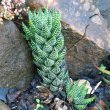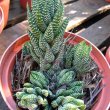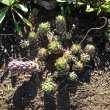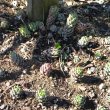| Botanical Name |
Haworthia coarctata var. coarctata |
| Family |
Asphodelaceae - The Asphodel family.
|
| Pronunciation |
ha-WORTH-ee-a koh-ark-TAY-tuh var. koh-ark-TAY-tuh |
| Common Name(s) |
|
| Plant Group |
- Ground Cover A plant with a low-growing, spreading habit, grown specifically to cover the ground.
- Succulent A plant having fleshy stems or leaves often adapted to dry conditions.
|
| Plant Size |
- Very Small
| Tree | 3m to 4m |
| Shrub | 25cm to 50cm |
| Perennial/ground cover | Up to 10cm |
| Bulb | 10cm to 20cm |
| Succulent | Up to 5cm |
|
| Position |
- Canopy Shade Canopy shade is found below closely grown trees where some light filters through. Ideal for the protection of herbaceous plants.
- Light or Dappled Shade Found below trees with sparse, open foliage. Ideal for the protection of herbaceous plants.
- Partial Shade The area is in shade for part of the day and in full sun for part of the day.
- Sun The area is in full sun for all or most of the day, all year round.
|
| General Information |
- Drought Tolerance: Moderate The plant is moderately adapted to arid conditions and can survive short periods of drought and high temperatures without extra water.
- Evergreen Plants that have leaves all year round.
- Frost: Half-hardy The plant is able to survive low temperatures and some frost but requires protection against severe frost.
- Water Moderate These plants will need some extra watering compared to water-wise plants. Plant them together, in at least some shade and in a convenient proximity to the house so that grey water can be utilised during times of drought.
|
| Specific Information |
Needs a little more water than most other succulents but must be well drained. This is one of the hardiest Haworthias for the garden. The leaves are tough, short, sharp, and closely packed. It propagates itself with side-shoots or 'pups'. In very dry or very cold conditions the leaves often turn pinkish. This colour, while attractive , means the plant is in stress. This will sort itself out as soon as the weather changes - but don't let them get too dry and turn brown.
|
| Ad Break |
|
| Flowers |
| Description |
Small, tubular, on long, thin stems.
|
| Season |
- Spring Plants will seldom bloom for the entire season as given in the list, but should flower during a period within these parameters.
|
| Colour |
|
| Growth Rate |
- Moderate Specifying growth rate can be very misleading as there is considerable variation of growth rate depending on type and species of plant, available water, supplementary feeding, mulching and general care, as well as the plants suitability and adaptability to the garden environment.
|
| Plant Uses |
- Container Trees, shrubs and ornamental species that can adapt to growing in a restricted environment.
- Edging A low growing plant that provides softness or definition to the edges of a bed or walkway.
- Filler Either a fast growing tree or shrub used temporarily to fill in an area while the permanent plants grow to a desired size, or a plant used to fill gaps in borders or beds.
- Ground Cover Low-lying plants that spread fast, require minimal maintenance, and cover large expanses or bare areas between bulbs or shrubs. They provide protection from erosion and drought and improve the visual appearance of the garden.
- Pot Plant A plant that needs a protected environment on a patio or indoors.
- Rock Garden An area constructed of larger rocks, arranged naturally, to emphasise the use of stones as a main element. Generally plants used do not need a lot of care.
- Suitable for smaller gardens Such plants do not have invasive root systems, remain small or controllable and can often be grown in containers.
- Water Features These plants may have dramatic, lush foliage or graceful form. They do not shed excessive leaves and do not have invasive root systems.
- Wild Garden An indigenous garden planted for the benefit of wildlife and birds. Provides food, water, a variety of mini-biomes and no poisonous chemicals are used.
|
| Distribution and Habitat |
Port Elizabeth to the Great Fish River in the Eastern Cape Province, in stony soil, among rocks on hillsides and often in exposed conditions
|
| Planting Suggestions |
Plant in any well drained garden soil enriched with a very little compost if needed for a very poor or porous soil. I mulch mine very lightly between the rosettes with milled bark as they do not like to be buried at the base. As with many Haworthias, they like a little shade, the protection of a shrub if you get frost and a little regular water to show themselves at their best.
|
| Medicinal Uses |
|
| Ad Break |
|








Comments
Rehab Haworthia
Hola,Would you offer an opinion on a plant if I can send a picture?
To submit a picture
Hi Doug
You can send a picture by sending me an email with attachment to kumbulanursery@gmail.com
We have planned to have the option of adding pictures with the comment box, but I have to wait for my webmasters to have a bit of spare time. Hopefully soon but in the meantime it has to be email.
Kind regards
Lorraine
Discuss this plant
Share knowledge, ask a question or give an experience.